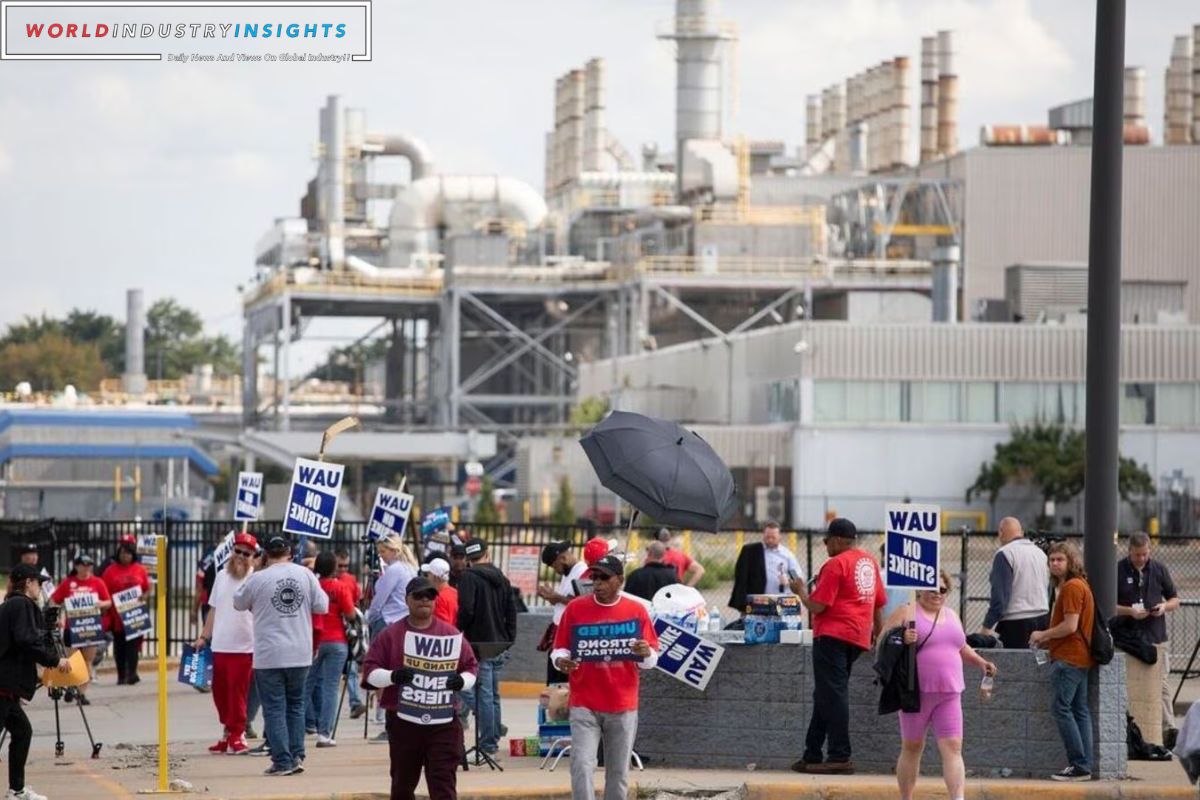Auto Industry Pay Landscape: The United Auto Workers (UAW) has secured record-breaking wage hikes and benefits for union workers at major auto companies, triggering a ripple effect in the automotive industry. As the Detroit Three automakersGeneral Motors, Ford, and Stellantisfinalize labor deals through 2028, non-union workers are witnessing an unprecedented shift in their compensation packages.
The UAW’s triumph includes a remarkable 25% increase in base wages, featuring an immediate 11% hike. Cumulatively, this will elevate the top wage by 33%, reaching over $42 an hour when factoring in estimated cost-of-living adjustments. The labor agreement also dismantles wage tiers in factories and slashes the time it takes to reach the top wage from eight years to three.
Embracing this victory, the UAW launched a social media campaign promoting the “UAW Bump” and encouraging non-union workers to consider joining the UAW. The union’s gaze has now shifted toward foreign-owned auto plants, including the likes of Tesla.
President Joe Biden has thrown his support behind the UAW’s efforts to unionize other carmakers, setting the stage for a significant transformation in the industry’s labor landscape.
Here’s a roundup of how various car companies are responding to the UAW’s success:
Tesla (TSLA.O): The electric car giant is set to raise wages by approximately 10% for specific set-rate hourly workers at its battery factory in Sparks, Nevada, starting in early January. There are also hints of streamlining several levels of workers.
Volkswagen (VOWG_p.DE): The German automaker plans to raise pay by 11% for non-union production workers at its Chattanooga assembly plant in Tennessee, effective December 2023.
Also Read: EV Roadblocks: Auto Industry Slows All-Electric Shift Amid Challenges
Nissan Motor (7201.T): Nissan is hiking top wages for workers at its U.S. manufacturing plants by 10% in January, impacting around 9,000 U.S. workers. Additionally, Nissan is eliminating wage tiers for U.S. production workers.
Hyundai Motor (005380.KS): Hyundai intends to raise wages for non-union production workers at its Alabama factory by an impressive 25% by 2028, influencing 4,000 hourly workers.
Honda Motor (7267.T): Honda is granting production workers at its U.S. facilities an 11% pay hike starting in January, coupled with a reduction in the time it takes factory workers to reach the top-wage tierfrom six years to three.
Toyota Motor (7203.T): Toyota is increasing the wages of nonunion U.S. factory workers, with hourly manufacturing workers at the top pay tier receiving a wage hike of about 9%, effective January 2024.
Subaru (7270.T): Subaru is gearing up to raise the wages of its U.S. plant workers in Lafayette, Indiana, with the exact raise amount yet to be determined.
The UAW’s success has not only empowered union workers but is reshaping the landscape for non-union workers, heralding a new era of heightened compensation and benefits in the American auto industry. As car companies respond to the UAW’s triumph, the dynamics of labor negotiations and worker compensation take center stage, setting the tone for the industry’s future.
Our Reader’s Queries
What is the highest paying job in the automobile industry?
Looking for a lucrative career in the automotive industry? Look no further than these high-paying positions. The dealership general manager can earn between $51,500 and $192,500 per year, while the heavy equipment sales manager can make anywhere from $71,000 to $155,500 annually. Other top-paying roles include automotive service director, transmission rebuilder, automotive general sales manager, used car manager, chassis engineer, and automotive sales manager. With such impressive earning potential, these jobs are sure to rev up your career.
What is the wage in the auto industry?
The Automotive Industry offers a wide range of salaries, with ZipRecruiter reporting annual earnings ranging from $33,000 to $110,500. However, the majority of professionals in this field earn between $45,500 and $78,500 per year, with the top 10% earning $104,500 annually.
What is the turnover rate in the automotive industry?
The automotive industry is currently experiencing a high mechanic turnover rate of 46%. However, this is just the tip of the iceberg as Forbes predicts a Turnover Tsunami due to pandemic burnout. With the world’s uncertainty, employees are feeling overwhelmed, undervalued, and exhausted from working long hours. This trend is expected to continue, making it crucial for companies to prioritize employee well-being and retention strategies.
How much money does the car industry make?
In 2022, the automotive manufacturing industry raked in a whopping 2.52 trillion U.S. dollars in revenue, but unfortunately, it was a bit of a dip from the previous year. However, the good news is that experts predict that this market size will bounce back and grow even bigger in 2023.


